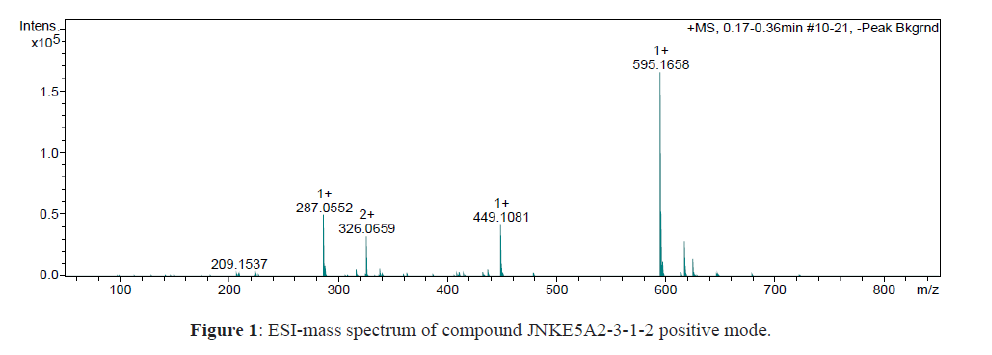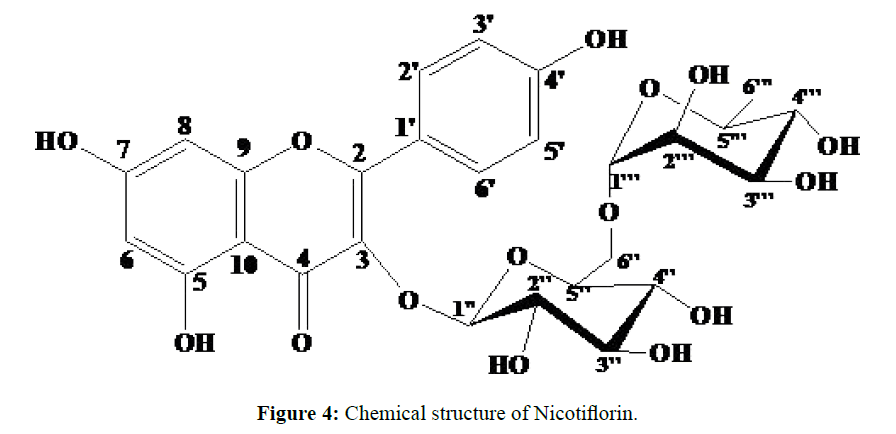Isolation and Identification of Nicotiflorin from the Leaves of Costus spectabilis (Fenzl) K. Schum

Costus spectabilis is a rhizomatous geophyte used by traditional medicine to treat internal and external wounds, coughs, inflammation, arthritis, rheumatism, fever, maternal and neonatal infections. It is also recommended for its laxative, purgative, diuretic and ichthyotoxic properties. A phytochemical study of the leaves of Costus spectabilis, revealed the presence of flavonoids, alkaloids, sterols and triterpenes, coumarins, reducing compounds, oses and holosides. The combination of chromatographic (CC and TLC), 1D NMR spectral (1H, 13C), 2D (COZY and HMQC) and spectrometric (ESI-MS positive mode) techniques allowed the isolation and identification of kaempferol 3- O- (6- O- (α-L-rhamnosyl) β-D-glucoside or nicotiflorin of the methanol extract of the leaves of Costus spectabilis. Costus spectabilis is a rhizomatous geophyte native to much of tropical Africa. In Mali, traditional medicine uses its leaves to treat internal and external wounds. Its leaves are also recommended against inflammation, arthritis, rheumatism, maternal and neonatal infections. They are also used to prepare the laxative, the purgative, the diuretic and are chewed and swallowed to give up fevers. Its tuberous roots are used for their ichthyotoxic properties. These pharmacological properties, whose interest is obvious, the new perspectives for the scientific valorization of Costus spectabilis. A study conducted in the United States at the University of Illinois (Chicago) in 2001 shows that the substances were medicated on the market, 122 transferred from plants. Of these naturally occurring molecules, 80% were used at the same time. This work concerns phytochemical screening, isolation and identification of a bioactive compound, a nicotiflorin methanol extract from the leaves of Costus spectabilis. As such, it is a promising field of research, a title of great champion of open applications, as well as the valorization of medicinal plants, the obtaining of new bioactive molecules.
The plant material consists of the leaves of Costus spectabilis, harvested in Siby (Bamako) in october 2015. After drying in the shade, the samples were ground to obtain 800 g of fine powder. Botanical identification was carried out at DMT-MALI and confirmed by the nomenclature of the Angiosperms Phylogeny Group classification (APG III, 2009). Columns; silica (230-400 Mesh); analytical and preparative TLC plates (GF 254); Kofler's bench; Bruker Avance III 500 MHz spectrometer for 1H and 125 MHz for 13C; Bruker quadrupole spectrometer under electrospray and in positive mode.

Yellow crystals soluble in MeOH, Rf = 3.6 (AcOEt / MeOH / Water: 10: 1: 1), mp 200°C. The SM / ESI spectrum shows a quasi-molecular ion [M-H] + at m / z 595 suggesting a molecular weight of 594u indicating the molecular formula C27H30O15. Fragmentation in ESI + of [M + Na] + reveals the ions at m / z 449 and at m / z 287 indicating the successive loss of a deoxyhexose (-146 u) then of a hexose (-146-162 u). In addition, the most abundant fragment at m / z 287 assumes the presence of a kaempferol genome (Figure 1).
Phytochemical screening of the leaves of Costus spectabilis revealed the presence of flavonoids, coumarins, alkaloids, sterols and triterpenes, reducing compounds, oses and holosides. The methanolic extract showed no moderate selectivity between cancer and non-cancer cells. These results suggest toxicity and should caution the traditional use of Costus spectabilis, despite its traditional pharmacological potential. Flavonoids are compounds known for their antioxidant properties, they are therefore at the origin of physiological effects beneficial for the human organism and deserve the growing interest that the research brings to them. Nicotiflorin (Figure 2) is a flavonoid diglycosyl type isolated from many plants including Astragalus verrucosus and Astragalus cruciatus, Heteropappus altaicus and H. Biennis, Solidago canadensis, Ficaria verna, Clitoria ternatea, Staphylea bumalda, Trigonotis peduncularis, Acalypha indica, Carthamus tinctorius, Caragana Bungei, Solanum campaniform, Osyris wightiana, Ampelopsis heterophylla, Amaranth and Aspergillus awamori. Although it is not an original structure, we note for the first time, the isolation of this compound from the leaves of Costus spectabilis.

We have found the presence of flavonoids, coumarins, alkaloids, sterols and triterpenes, reducing compounds, oses and holosides in the leaves of Costus spectabilis. This work also isolated nicotiflorin for the first time from Costus spectabilis. This molecule could be used to study and explain the medicinal properties of Costus spectabilis. For greater efficiency, we envision many perspectives including expanding the panel of activities by determining the acute oral toxicity, haemolysis, and cytotoxicity of the aqueous extract to assess the safety of use of Costus spectabilis, and continue the chemical investigations of other extracts of Costus spectabilis.
With Regards,
Joseph Kent
Journal Manager
Journal of Der Chemica Sinica